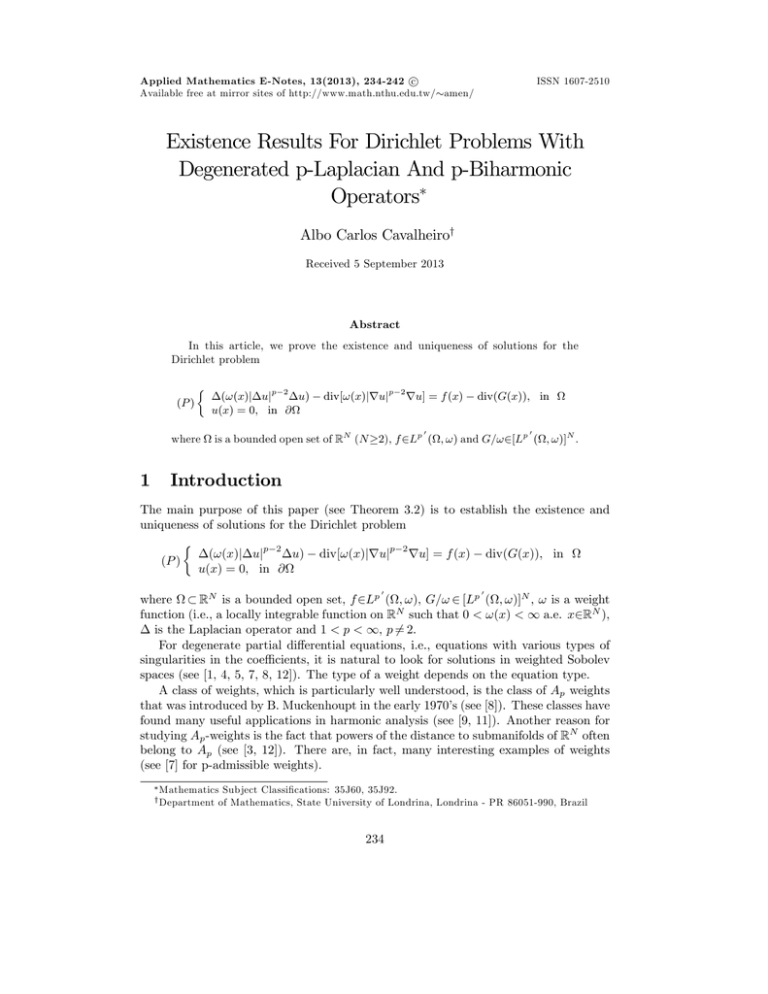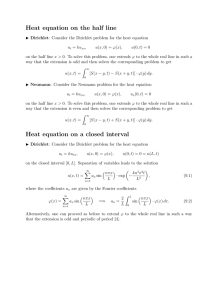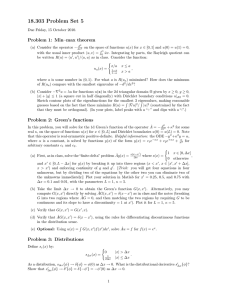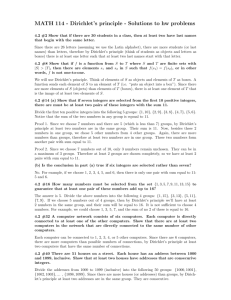Document 10677528
advertisement

Applied Mathematics E-Notes, 13(2013), 234-242 c
Available free at mirror sites of http://www.math.nthu.edu.tw/ amen/
ISSN 1607-2510
Existence Results For Dirichlet Problems With
Degenerated p-Laplacian And p-Biharmonic
Operators
Albo Carlos Cavalheiroy
Received 5 September 2013
Abstract
In this article, we prove the existence and uniqueness of solutions for the
Dirichlet problem
(!(x)j ujp 2 u)
u(x) = 0; in @
(P )
where
1
div[!(x)jrujp
2
ru] = f (x)
div(G(x)); in
0
0
is a bounded open set of RN (N 2), f 2Lp ( ; !) and G=!2[Lp ( ; !)]N .
Introduction
The main purpose of this paper (see Theorem 3.2) is to establish the existence and
uniqueness of solutions for the Dirichlet problem
p 2
(P )
(!(x)j uj
u)
u(x) = 0; in @
div[!(x)jruj
0
p 2
ru] = f (x)
div(G(x)); in
0
where
RN is a bounded open set, f 2Lp ( ; !), G=! 2 [Lp ( ; !)]N , ! is a weight
function (i.e., a locally integrable function on RN such that 0 < !(x) < 1 a.e. x2RN ),
is the Laplacian operator and 1 < p < 1, p 6= 2.
For degenerate partial di¤erential equations, i.e., equations with various types of
singularities in the coe¢ cients, it is natural to look for solutions in weighted Sobolev
spaces (see [1, 4, 5, 7, 8, 12]). The type of a weight depends on the equation type.
A class of weights, which is particularly well understood, is the class of Ap weights
that was introduced by B. Muckenhoupt in the early 1970’s (see [8]). These classes have
found many useful applications in harmonic analysis (see [9, 11]). Another reason for
studying Ap -weights is the fact that powers of the distance to submanifolds of RN often
belong to Ap (see [3, 12]). There are, in fact, many interesting examples of weights
(see [7] for p-admissible weights).
Mathematics Subject Classi…cations: 35J60, 35J92.
of Mathematics, State University of Londrina, Londrina - PR 86051-990, Brazil
y Department
234
A. C. Cavalheiro
235
1), for all f 2 Lp ( ) the Poisson
In the non-degenerate case (i.e. with !(x)
equation associated with the Dirichlet problem
u = f (x); in
u(x) = 0; in @
is uniquely solvable in W 2;p ( ) \ W01;p ( ) (see [6]), and the nonlinear Dirichlet problem
p u = f (x); in
u(x) = 0; in @
p 2
is uniquely solvable in W01;p ( ) (see [2]), where p u = div(jruj ru) is the pLaplacian operator. In the degenerate case, the weighted p-Biharmonic operator have
been studied by many authors (see [10] and the references therein), and the degenerated
p-Laplacian has been studied in [3].
The paper is organized as follow. In Section 2 we present the de…nitions and basic
results. In Section 3 we prove our main result about existence and uniqueness of
solutions for problem (P ).
2
De…nitions and Basic Results
By a weight we shall mean a locally integrable function ! on RN such that 0 < !(x) <
1 for a.e. x 2 RN . Every weight ! gives rise to a measure on the measurable subsets
of RN through integration. This measure will be denoted by . Thus,
Z
(E) =
!(x)dx for measurable sets E RN :
E
DEFINITION 2.1. Let 1 p < 1. A weight ! is said to be an Ap -weight, if there
is a positive constant C = C(p; !) such that, for every ball B RN
1
jBj
Z
!(x) dx
B
1
jBj
Z
1
jBj
Z
p 1
! 1=(1
p)
(x) dx
C if p > 1;
B
!(x) dx
ess sup
x2B
B
1
!(x)
C if p = 1;
where j j denotes the N -dimensional Lebesgue measure in RN .
If 1 < q
p, then Aq Ap (see [5, 7, 12] for more information about Ap -weights).
As an example of an Ap -weight, the function !(x) = jxj , x 2 RN , is in Ap if and only
if N < < N (p 1) (see [11], Chapter IX, Corollary 4.4). If ' 2 BM O(RN ), then
!(x) = e '(x) 2 A2 for some > 0 (see [9]).
REMARK 2.2. If ! 2 Ap , 1 < p < 1, then
jEj
jBj
p
C
(E)
(B)
236
Existence Results for Dirichlet Problems
for all measurable subsets E of B (see 15.5 strong doubling property in [7]). Therefore,
if (E) = 0, then jEj = 0. Thus, if fun g is a sequence of functions de…ned in B and
un ! u -a.e. then un ! u a.e.:
DEFINITION 2.3. Let ! be a weight. We shall denote by Lp ( ; !) (1
the Banach space of all measurable functions f de…ned in for which
kf kLp (
;!)
Z
=
p < 1)
1=p
p
jf (x)j !(x)dx
< 1:
We denote [Lp ( ; !)]N = Lp ( ; !) ::: Lp ( ; !).
REMARK 2.4. If ! 2 Ap , 1 < p < 1, then since ! 1=(p 1) is locally integrable,
we have Lp ( ; !) L1loc ( ) (see [12], Remark 1.2.4). It thus makes sense to talk about
weak derivatives of functions in Lp ( ; !).
DEFINITION 2.5. Let
RN be a bounded open set, 1 < p < 1, k be a nonnegative integer and ! 2 Ap . We shall denote by W k;p ( ; !), the weighted Sobolev
spaces, the set of all functions u 2 Lp ( ; !) with weak derivatives D u 2 Lp ( ; !),
1 j j k. The norm in the space W k;p ( ; !) is de…ned by
kukW k;p (
;!)
0
=@
Z
p
ju(x)j !(x)dx +
X Z
1 j j k
11=p
p
jD u(x)j !(x)dxA
:
(1)
We also de…ne the space W0k;p ( ; !) as the closure of C01 ( ) with respect to the
norm
kukW k;p (
0
;!)
0
=@
X Z
1 j j k
11=p
p
jD u(x)j !(x)dxA
The dual space of W01;p ( ; !) is the space [W01;p ( ; !)] = W
W
1;p 0
( ; !) = fT = f
div(G) : G = (g1 ; :::; gN );
1;p0
:
( ; !),
0
f gj
;
2Lp ( ; !)g:
! !
It is evident that a weight function ! which satis…es 0 < C1
!(x)
C2 , for
a.e. x 2 , gives nothing new (the space W k;p ( ; !) is then identical with the classical
Sobolev space W k;p ( )). Consequently, we shall be interested in all above such weight
functions ! which either vanish somewhere in [ @ or increase to in…nity (or both).
We need the following basic result.
A. C. Cavalheiro
237
THEOREM 2.6 (The weighted Sobolev inequality). Let
RN be a bounded open
set and let ! be an Ap -weight, 1 < p < 1. Then there exists positive constants C
and such that, for all f 2 C01 ( ) and 1
N=(N 1) + ;
kf kL
p(
;!)
C kjrf jkLp (
;!) :
(2)
PROOF. See [4], Theorem 1.3.
3
Weak Solutions
We denote by X = W 2;p ( ; !)\W01;p ( ; !) with the norm
Z
kukX =
p
jruj ! dx +
Z
1=p
p
:
j uj ! dx
In this section we prove the existence and uniqueness of weak solutions u 2 X to
the Dirichlet problem
p 2
(P )
where
(!(x)j uj
u)
u(x) = 0; in @
div[!(x)jruj
p 2
ru] = f (x)
div(G(x)); in
0
is a bounded open set of RN (N
0
2), f =! 2 Lp ( ; !) and G=![Lp ( ; !)]N .
DEFINITION 3.1. We say that u 2 X is a weak solution for problem (P ) if
Z
j uj
p 2
u ' !(x) dx +
Z
p 2
!(x) jruj
hru; r'i dx =
0
Z
f ' dx +
Z
hG; r'i dx;
(3)
0
for all ' 2 X, with f =! 2 Lp ( ; !) and G=! 2 [Lp ( ; !)]N .
0
0
THEOREM 3.2. Let ! 2 Ap , 1 < p < 1, f =! 2 Lp ( ; !) and G=! 2 [Lp ( ; !)]N .
Then the problem (P ) has a unique solution u 2 X.
PROOF. (I) Existence. By Theorem 2.6, we have that
Z
Z
f 'dx
C
C
f
!
p0
! dx
!1=p 0
Z
f
!
Lp 0 ( ;!)
kr'kLp (
f
!
Lp 0 ( ;!)
k'kX ;
1=p
p
j'j !dx
;!)
(4)
238
Existence Results for Dirichlet Problems
and
Z
Z
hG; r'idx
Z
Z
=
De…ne the functional Jp : X ! R by
1
Jp (') =
p
Z
1
j 'j !dx +
p
p
Z
jhG; r'ijdx
(5)
jGjjr'jdx
jGj
jr'j!dx
!
G
!
Lp 0 ( ;!)
kr'kLp (
G
!
Lp0 ( ;!)
k'kX :
p
jr'j !dx
Z
f 'dx
;!)
(6)
Z
hG; r'idx:
Using (4), (5) and Young’s inequality, we have that
1
p
Jp (')
Z
p
j 'j !dx +
1
p
Z
jr'jp !dx
!
G
C
+
k'kX
! Lp 0 ( ;!)
Lp 0 ( ;!)
Z
Z
1
1
1
p
j 'j !dx +
jr'jp !dx
k'kpX
p
p
p
# p0
G
+
! Lp0 ( ;!)
"
#p0
1
G
f
C
+
;
p0
! Lp0 ( ;!)
! Lp0 ( ;!)
f
!
=
"
1
C
p0
f
!
Lp0 ( ;!)
that is, Jp is bounded from below.
Let fun g be a minimizing sequence, that is, a sequence such that
Jp (un )! inf Jp (') :
'2X
Then for n large enough, we obtain that
0
Jp (un ) =
1
p
Z
p
j un j ! dx +
1
p
Z
jrun jp ! dx
Z
f un dx
Z
hG; run i dx;
A. C. Cavalheiro
239
and we get (by Theorem 2.6)
kun kpX
p
p
Z
f un dx +
f
!
p C
Z
kun kX
"
G
;!) +
!
Lp 0 ( ;!)
kun kLp (
f
!
G
+
!
;!)
Lp 0 (
f
p C k k 0
! Lp (
Hence
hG; run idx
p C
;!)
f
!
+k
L p0 (
Lp 0 ( ;!)
Lp 0 ( ;!)
G
k
! Lp 0 (
!
krun kLp (
;!)
;!)
kun kX :
;!)
G
+
!
;!)
krun kLp (
!
Lp 0 ( ;!)
!#1=(p
1)
:
Therefore fun g is bounded in X. Since X is re‡exive, there exists a u 2 X such that
un * u in X. Since
Z
Z
X 3 ' 7!
f 'dx +
hG; r'idx
and ' 7! kr'kLp ( ;!) + k 'kLp ( ;!) are continuous then Jp is continuous. Moreover
since 1 < p < 1 we have that Jp is convex and thus lower semi-continuous for the
weak convergence. It follows that
Jp (u)
lim inf Jp (un ) = inf Jp (');
n
'2X
and thus u is a minimizer of Jp on X. For any ' 2 X the function
Z
Z
Z
1
1
p
p
j (u + ')j !dx +
jr(u + ')j !dx
(u + ')f dx
7!
p
p
Z
hG; r(u + ')idx
has a minimum at
= 0. Hence
d
Jp (u + ')
d
=0
= 0; 8' 2X:
We have that
d
(jr(u + 'jp !) = pfjr(u + ')jp
d
2
d
p
(j (u + ')j !) = pj u +
d
'j
(hru; r'i + jr'j2 )g!;
and
p 2
( u+
') '!;
240
Existence Results for Dirichlet Problems
and we obtain that
0
d
Jp (u + ')
d
=0
Z
1
p 2
=
p
j u+
'j ( u +
') ' ! dx
p
Z
1
+
p
jr(u + ')jp 2 (hru; r'i + jr'j2 )!dx
p
Z
Z
'f dx
hG; r'idx
=0
Z
Z
p 2
=
j uj
u '!dx +
jrujp 2 hru; r'i ! dx
Z
Z
f 'dx
hG; r'i dx:
=
Therefore
Z
j uj
p 2
u '!dx +
Z
jruj
p 2
hru; r'i!dx =
Z
f 'dx +
Z
hG; r'i dx;
for all ' 2 X, that is, u 2 X is a solution of problem (P ).
(II) Uniqueness. If u1 ; u2 2 X = W 2;p ( ; !)\W01;p ( ; !) are two weak solutions of
problem (P ), we have (for i = 1; 2)
Z
j ui jp
2
ui '!dx +
Z
jrui jp
2
hrui ; r'i!dx =
Z
f 'dx +
Z
hG; r'idx;
for all ' 2 X. Hence
Z
+
=
0:
j
Z
u1 jp
2
jru1 jp
u1
2
j u2 jp
hru1 ; r'i
2
u2
'!dx
jru2 jp
2
hru2 ; r'i !dx
Taking ' = u1 u2 , and using that for every x; y 2 RN there exist two positive
constants p and p such that
p (jxj
+ jyj)p
2
jx
yj
hjxj
p 2
x
(see Proposition 17.3 in [2]) we obtain
jyj
p 2
y; x
yi
p
(jxj + jyj)p
2
jx
yj;
A. C. Cavalheiro
0
=
+
=
Z
Z
Z
+
Z
241
j u1 jp
2
jru1 jp
2
j u1 jp
2
Z
hjru1 jp
j u2 jp
u1
hru1 ; ru1
2
ru1
u2 ( u1
ru2 i
j u2 jp
u1
2
2
jru2 jp
2
Therefore u1 =
(by Remark 2.2).
hru2 ; ru1
u2 ) !dx
ru2 ; ru1
ru2 i!dx
(7)
ru2 i !dx
u2 j)!dx
ru2 j!dx:
u2 and ru1 = ru2 -a.e. and since u1 ; u2 2 X, then u1 = u2 a.e..
= f(x; y) 2 R2 : x2 + y 2 < 1g, w(x; y) = (x2 + y 2 )
EXAMPLE. Let
p = 3),
f (x; y) =
2
u2 ( u1
(j u1 j + j u2 j)p 2 (j u1
Z
p 2
+ p
(jru1 j + jru2 j)
jru1
p
jru2 jp
u2 ) !dx
cos(xy)
and G(x; y) =
+ y 2 )1=6
(x2
sin(x + y)
sin(xy)
; 2
2
2
1=6
(x + y )
(x + y 2 )1=6
1=2
(! 2A3 ,
:
By Theorem 3.2, the problem
((x2 + y 2 ) 1=2 j uj u)
u(x) = 0; in @
div[(x2 + y 2 )
1=2
jrujru] = f (x)
div(G(x)); in
has a unique solution u 2 X = W 2;3 ( ; !)\W01;3 ( ; !).
References
[1] A. C. Cavalheiro, Existence and uniqueness of solutions for some degenerate nonlinear Dirichlet problems, J. Appl. Anal., 19(2013), 41–54.
[2] M. Chipot, Elliptic Equations: An Introductory Course, Birkhäuser, Berlin, 2009.
[3] P. Drábek, A. Kufner and F. Nicolosi, Quasilinear Elliptic Equations with Degenerations and Singularities, de Gruyter Series in Nonlinear Analysis and Applications,
5. Walter de Gruyter & Co., Berlin, 1997.
[4] E. Fabes, C. Kenig and R. Serapioni, The local regularity of solutions of degenerate
elliptic equations, Comm. PDEs 7(1982), 77–116.
242
Existence Results for Dirichlet Problems
[5] J. Garcia-Cuerva and J. L. Rubio de Francia, Weighted Norm Inequalities and
Related Topics, North-Holland Mathematics Studies, 116. Notas de Matemática
[Mathematical Notes], 104. North-Holland Publishing Co., 1985.
[6] D. Gilbarg and N. S. Trudinger, Elliptic Partial Equations of Second Order, 2nd
Ed., Springer, New York, 1983.
[7] J. Heinonen, T. Kilpeläinen and O. Martio, Nonlinear Potential Theory of Degenerate Elliptic Equations, Oxford Math. Monographs, Clarendon Press, 1993.
[8] B. Muckenhoupt, Weighted norm inequalities for the Hardy maximal function,
Trans. Am. Math. Soc., 165(1972), 207–226.
[9] E. Stein, Harmonic Analysis, Princenton University, 1993.
[10] M. Talbi and N. Tsouli, On the spectrum of the weighted p-Biharmonic operator
with weight, Mediterranean J. of Math., 4(2007), 73–86.
[11] A. Torchinsky, Real-Variable Methods in Harmonic Analysis, Academic Press, San
Diego, 1986.
[12] B. O. Turesson, Nonlinear Potential Theory and Weighted Sobolev Spaces, Lecture
Notes in Mathematics, vol. 1736, Springer-Verlag, 2000.







